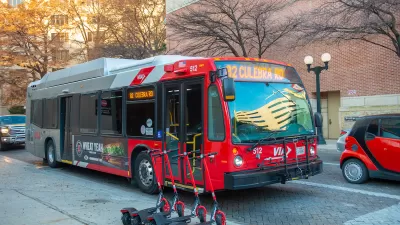Nick Addamo discusses and outlines the plans of five small and mid-sized cities that are re-evaluating their waterfront and developing them to be more people-focused.

In a recent piece on Architizer, Nick Addamo writes how in the face of, "globalization and post-industrialization, many once-buzzing urban ports and waterfronts have fallen into disuse and disrepair. As cities around the world become increasingly environmentally conscious, and shift their planning to be more people-focused, designers are honing in on waterfronts more than ever, with facelifts in the form of parks, plazas, or even commercial development."
Indeed, these industrial swaths of waterfront previously reserved for commerce are now becoming urban amenities, providing residents with a breath of green space and fresh air. Addamo outlines the projects happening in Pittsburgh, Washington D.C., Hartford, Connecticut, and Nashville. All of these projects are in various states of the design or construction process.
While many times, larger cities like New York, Chicago, or Los Angeles get the limelight for their urban waterfront revitalization projects, these smaller cities are also developing impressive projects for their city-dwellers.
FULL STORY: 9 Cities That Are Hacking Their Urban Waterfronts

Trump Administration Could Effectively End Housing Voucher Program
Federal officials are eyeing major cuts to the Section 8 program that helps millions of low-income households pay rent.

Planetizen Federal Action Tracker
A weekly monitor of how Trump’s orders and actions are impacting planners and planning in America.

The 120 Year Old Tiny Home Villages That Sheltered San Francisco’s Earthquake Refugees
More than a century ago, San Francisco mobilized to house thousands of residents displaced by the 1906 earthquake. Could their strategy offer a model for the present?

HSR Reaches Key Settlement in Northern California City
The state’s high-speed rail authority reached an agreement with Millbrae, a key city on the train’s proposed route to San Francisco.

Washington State Legislature Passes Parking Reform Bill
A bill that would limit parking requirements for new developments is headed to the governor’s desk.

Missouri Law Would Ban Protections for Housing Voucher Users
A state law seeks to overturn source-of-income discrimination bans passed by several Missouri cities.
Urban Design for Planners 1: Software Tools
This six-course series explores essential urban design concepts using open source software and equips planners with the tools they need to participate fully in the urban design process.
Planning for Universal Design
Learn the tools for implementing Universal Design in planning regulations.
Ada County Highway District
Clanton & Associates, Inc.
Jessamine County Fiscal Court
Institute for Housing and Urban Development Studies (IHS)
City of Grandview
Harvard GSD Executive Education
Toledo-Lucas County Plan Commissions
Salt Lake City
NYU Wagner Graduate School of Public Service




























